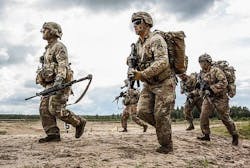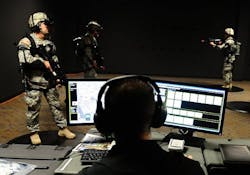Army unveils plan for immersive infantry simulator to enable squad members to train together
Officials of the Army Contracting Command in Orlando, Fla., issued a statement of need (W900KK-SYNTHETIC-TRAINING-ENVIRONMENT-SiVT) on Tuesday for the Squad Immersive Virtual Trainer (SiVT) to provide defense contractors with additional information about this possible future program.
The goal of the SiVT is to provide a realistic small-unit simulations trainer to provide squad members with an increased number of training repetitions well above the rate possible during live training exercises. An infantry squad has nine to 13 warfighters.
The SiVT will use mixed reality and natural user interface (NUI) technologies to deliver capabilities that include engine-agnostic software able to interoperate with future Army training devices; interoperability with the Army's Commons Synthetic Environment (CSE) for individual and collective training; the ability for soldiers to build and design scenarios rapidly that portray constantly changing real-world situations; the ability to run several training iterations in a short period of time; and provide after action reviews.
The Army fielded the first-generation Dismounted Soldier Training System (DSTS) from 2012 to 2014, but it didn't fulfill infantry training requirements and was scrapped in 2015, Army officials explain.
Related: The next generation of simulation-based training
Today the Army's lack of a squad immersive capability prevents squads from conducting several different training scenarios quickly that involve varying conditions at different operating tempos and levels of complexity. Army officials say that filling this training gap will increase squad proficiency in small-unit close-combat operations.
Army experts are considering an initial SiVT prototype that is transportable and deployable, portrays global terrain, and operates with an agnostic software engine. The idea is to develop additional simulator capabilities through an iterative technology demonstration approach.
This could enable the Army to field additional simulator prototypes to gain real-time user feedback. The Army would like to coordinate a technical demonstration of prototypes using real soldiers no later than August 2018.
The SiVT should not be complex to operate and maintain; must replicate current and future infantry squad communications and weapons; and must track each soldier's progress. It also must enable squad members to engage a simulated enemy with all the squad's individual and crew-served weapons.
It must provide marksmanship and tactical algorithms able to support training that ranges from individual basic marksmanship to full squad tactical training, and be able to integrate new weapons quickly. The SiVT will include replicate human voices, battlefield noises, vehicle movement, infantry weapons, and aircraft.
SiVT users must be able to deploy, maneuver and shoot to defeat and destroy enemy forces and seize terrain, resources, and population centers.
Squad leaders should be able to think tactically and use information to assess the situation, make decisions, and issue orders in an austere environment. Hand and arm gestures and facial expressions must be detailed enough to enable Soldiers to communicate without speaking and maintain noise and light discipline during movement.
The system also must replicate current and future squad-level voice and data communications systems like Netwarrior and input from unmanned aircraft, and must replicate face-to-face communications with friends, enemies, civilians and unmanned aircraft.
The SiVT will help soldiers care for the wounded on the spot or under nearby cover and concealment until a combat medic is available, as well as request medical evacuation. Safety features will help soldiers not to shoot or otherwise hurt each other, protect themselves from chemical, biological, radiological, nuclear, and high-yield explosives attack.
The simulator will replicate terrain and conditions like deserts, snow, mountains, jungles, cities, underground facilities in 3D, including actions like digging, explosions, and battlefield damage.
This simulator will about the size of an Army classroom, and be modular, exportable, tailorable, transportable, and scalable. Floor space will not be larger than 40 by 40 feet, and support training one to 15 soldiers at once.
This statement of need is for information only, and will be updated periodically. Email questions or concerns to the Army's Ian Skeete at [email protected] or Brian Wepking at [email protected].
More information is online at https://www.fbo.gov/notices/b9f0a97d81b299781f39070d17d1a9db.
Ready to make a purchase? Search the Military & Aerospace Electronics Buyer's Guide for companies, new products, press releases, and videos

